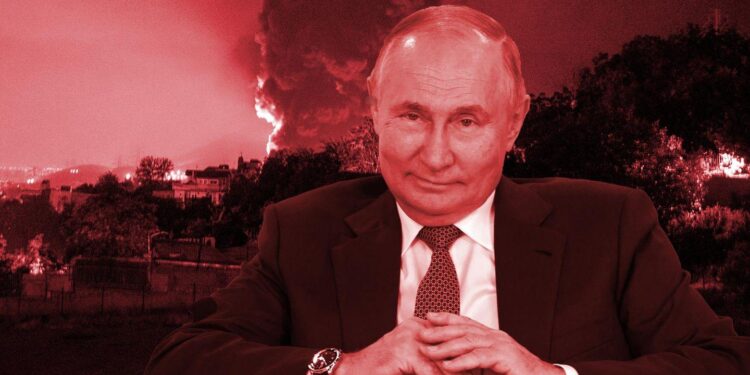As the conflict in Ukraine enters its second year, new intelligence and strategic assessments suggest that Russian President Vladimir Putin may be preparing to escalate the war by opening an additional front. Such a move could dramatically alter the dynamics on the ground, posing heightened risks not only for Ukraine but for regional stability and international security. This analysis explores the potential scenarios behind Putin’s next steps, the motivations driving Moscow’s strategy, and the far-reaching implications of a broader conflict.
Putin’s Strategic Calculus in Opening a New Front Against Ukraine
Vladimir Putin’s decision to potentially open a new front in Ukraine is guided by a calculated strategy aimed at stretching Ukrainian defenses and destabilizing Western support. By initiating hostilities away from the primary battlegrounds in the east and south, Moscow seeks to create a multifaceted conflict environment where Ukrainian forces must divide their attention and resources. This approach not only complicates Kyiv’s military logistics but also tests the cohesion among NATO allies providing aid and intelligence.
Key elements of Putin’s strategic calculus include:
- Exploitation of regional vulnerabilities: Identifying weaker points along Ukraine’s northern or western borders to maximize operational surprise.
- Psychological pressure: Shifting the battle lines to sow uncertainty and diminish morale among Ukrainian troops and civilians.
- Diplomatic leverage: Forcing Western capitals into difficult decisions regarding escalation and aid delivery, thereby influencing broader geopolitical dynamics.
| Factor | Potential Impact | Russian Objective |
|---|---|---|
| Northern Front Opening | Diverts Ukrainian troops from Donbas | Stretch defenses, break frontline cohesion |
| Increased Hybrid Warfare | Creates confusion and misinformation | Weaken enemy command and control |
| International Response Fatigue | Slows pace of aid and sanctions implementation | Gain negotiation advantage |
Potential Regional Consequences and Escalation Risks
Should Russia escalate by opening a new front, the regional fallout could be severe and multifaceted. Neighboring countries, already bracing for instability, risk becoming collateral in an expanding conflict zone. Nations bordering Ukraine may face increased refugee flows, disrupting social services and straining economies. Moreover, Moscow’s strategy could exacerbate existing ethnic and political tensions within Eastern Europe, potentially igniting proxy conflicts that complicate diplomatic efforts.
Escalation risks extend beyond immediate geography, threatening to redraw security dynamics across the continent. Key concerns include:
- Heightened NATO-Russian confrontation: Increased military posturing could inadvertently trigger miscalculations between Moscow and Western powers.
- Energy supply disruptions: The region’s crucial pipelines and energy infrastructure could become targets, driving up global prices.
- Economic sanctions tightening: Further escalation would likely prompt harsher sanctions, deepening Russia’s isolation and impacting global markets.
| Potential Impact Zone | Key Concern | Immediate Implication |
|---|---|---|
| Eastern Europe | Refugee Crisis | Humanitarian Strain |
| Black Sea Region | Naval Blockades | Trade Disruptions |
| Central Europe | Energy Security | Price Volatility |
Policy Recommendations for Cohesive International Response
To counter the escalating threat, the international community must prioritize a unified and strategic approach. Enhanced intelligence-sharing among Western allies is imperative to detect and preempt any new incursions swiftly. Equally crucial is the reinforcement of economic sanctions, targeting individuals and entities complicit in enabling aggressive maneuvers, thereby tightening the financial noose around Moscow’s military ambitions. Diplomatic pressure should be sustained and amplified, with forums like the United Nations and the OSCE serving as platforms to maintain global focus on the conflict and to isolate Russia politically.
- Strengthen NATO’s Eastern Flank: Increase troop deployments and joint exercises with Ukraine’s neighbors.
- Support Cyber Defense: Provide Ukraine with advanced tools to combat escalating cyber attacks.
- Humanitarian Aid: Coordinate efforts to assist displaced populations and maintain critical infrastructure.
| Action | Expected Outcome | Timeline |
|---|---|---|
| Sanctions Expansion | Weaken Kremlin’s resource base | Immediate |
| Military Intelligence Sharing | Early threat detection | Ongoing |
| Cybersecurity Training | Resilience against cyber warfare | Short-term |
The complexity of Putin’s potential new front demands not only military readiness but also a holistic policy perspective blending hard and soft power. Western governments must maintain a consistent communication line with Kyiv while engaging with neutral states to build broader coalitions. This dual approach fortifies deterrence while creating openings for negotiation toward a sustainable resolution. Failing to act decisively risks emboldening Russia’s strategic calculus, potentially triggering a broader and more destabilizing regional conflict.
Future Outlook
As the conflict in Ukraine continues to evolve, the possibility of Russia opening a new and dangerous front could mark a significant escalation with far-reaching consequences. Analysts and policymakers alike will be closely monitoring Moscow’s next moves, aware that any expansion of hostilities risks further destabilizing the region and complicating international efforts toward a resolution. The coming weeks may prove critical in determining whether diplomacy can prevail or if the conflict will deepen into an even more protracted and perilous confrontation.
















